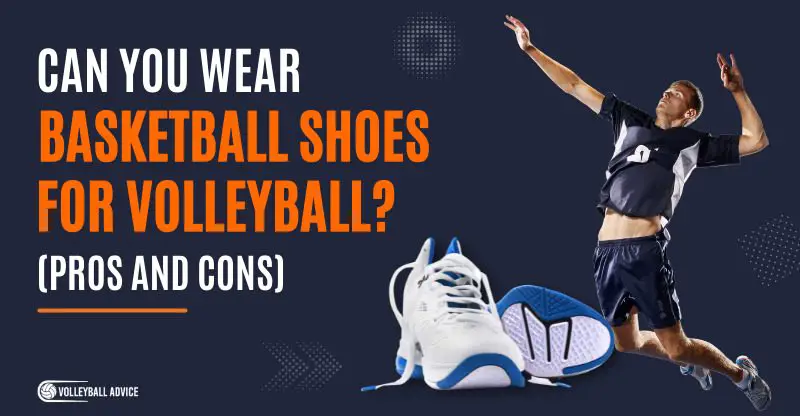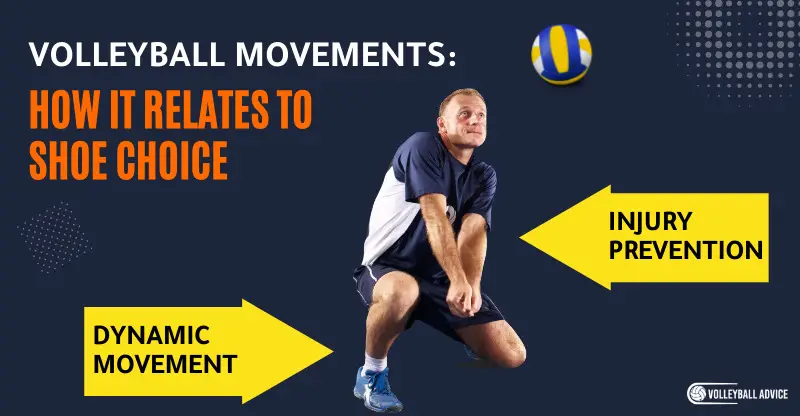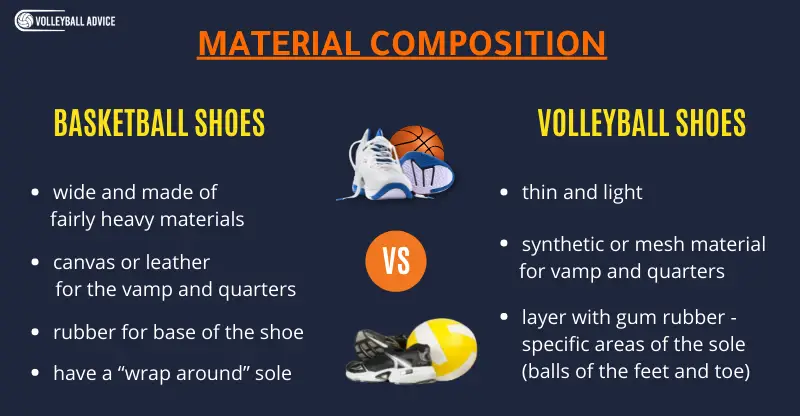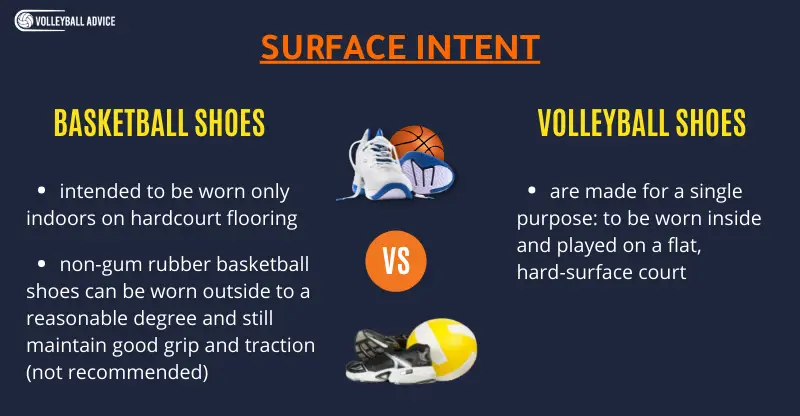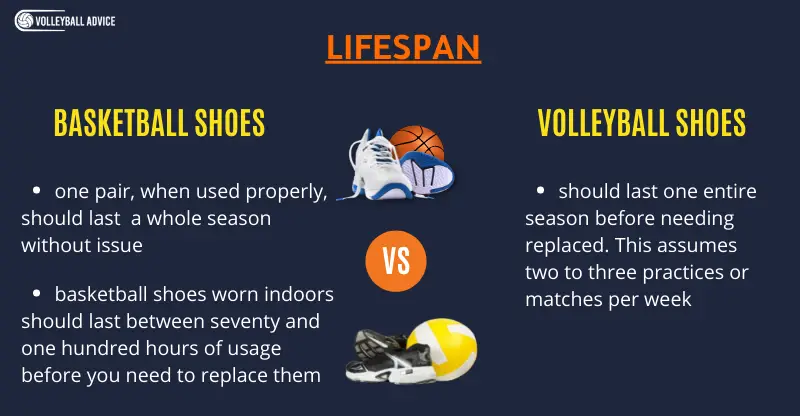Can You Wear Basketball Shoes For Volleyball? (Pros and Cons)
Some links in this article are affiliate links, which means I earn from qualifying purchases.
Basketball and volleyball include a lot of the same dynamic movements. Because of this, many players have played both – especially in high school when the two seasons are back to back – or switching between them.
This leads many athletes to wonder about the differences between basketball and volleyball shoes, and whether they can wear one pair for both sports, or whether they need to buy separate shoes.
So, can you wear basketball shoes for volleyball? Yes, you can absolutely wear basketball shoes for volleyball. However, basketball shoes offer less cushioning for jumping, are heavier (which can make you tire quicker), and lack the “volleyball eyelet” that anchors your laces for a tighter fit. Therefore, as you progress, you may want to buy volleyball-specific shoes.
In this article, I’m going to break down the differences between volleyball vs basketball shoes, highlight some of the benefits each gives, and show how you can find success with either shoe option.
Volleyball Movements: How It Relates To Shoe Choice
Some sports’ shoes should never mix: such as running shoes and volleyball. Choosing the right shoe for the right sport is important to enjoying the game and avoiding injury.
However, some shoes are viable for more than one occasion.
Basketball shoes are one of these, and are commonly used for volleyball – even by many university-level players. They are a comfortable fit with great lateral support for some fancy footwork, and are a perfectly good option for playing volleyball at almost any level.
But they don’t stand up to the best volleyball shoes.
If you look at professional volleyball players, you will rarely (if ever) see them wearing basketball shoes. This is no coincidence and goes far beyond branding and personal preference. If you want to perform at the highest level of your ability in a given sport, you need to consider the movements that define it.
To begin to understand the effect volleyball has on both basketball and volleyball shoes, we need to discuss two things:
- Dynamic Movement
- Injury Prevention
1. Dynamic Movement: The Vertical Wall
Volleyball and basketball are both filled with quick, light actions, and movements that require a lot of lateral – side-to-side – movements.
This is different from forward dynamic movements, such as driving or sprinting in basketball, or diving and approaching in volleyball. Together, these are what are commonly referred to as “dynamic movements”.
Both volleyball and basketball shoes give good forward dynamic support, and although each offer good lateral support, basketball shoes are traditionally a little better in this area due to the unpredictable pattern of dribbling. After all, “ankle-breaking” would be a lot less funny without basketball shoes’ support to prevent serious injury.
Where the two shoes diverge, however, is the third aspect of dynamic movement: vertical.
Volleyball incorporates a lot of jumping. This isn’t exclusive to volleyball, and although basketball obviously has this aspect as well, it is nowhere near the same amount as volleyball. More than any other sport, volleyball is a battle to overcome that vertical wall: gravity.
Consider that the average player has a vertical of 20” for men’s volleyball. If they jump just three times during a single point, they will have risen five feet into the air from spiking and blocking. If a front court player jumps twice every ten seconds – once to spike, once to block – then it is easy to imagine the stress that continuous landing can have on the body.
Compare this to basketball, where jumping is done primarily to gain possession of the ball or to score, where a period of twenty-four seconds can legally elapse between shots on basket. https://www.whisperingcreekdentistry.com/ Since there is no net to get above in order to hit or block, basketball players do not need to jump their highest every time the same way volleyball players do.
For volleyball, the sheer volume of vertical movement makes it unique, and the difference in movement for these sports translates directly to the design of the shoes.
Basketball shoes provide both forward and lateral movement support, but they lack the cushioning to withstand the amount of jumping that occurs in volleyball. style=”font-weight: 400;”> They are also heavier and wider, which while unnoticeable in basketball may tire you out in volleyball.
Lighter shoes with proper cushioning are needed to maintain this kind of jumping, and this is the main functionality and design of volleyball shoes.
Basketball shoes are not the wrong choice to play volleyball in, but it is important to understand how they affect your movement. Most of the time, much of these differences won’t matter, but when your team is pushed to the wire and struggling to keep jumping, they might make all the difference.
2. Injury Prevention
Long ago, my physical trainer told me: prevention is always better than the cure. As it turns out, his sage advice wasn’t so radical, and certainly not unique.
This phrase was attributed to the Dutch philosopher Desiderius Erasmus in the sixteenth century, and has withstood the test of time to be a pillar of modern health care today.
Let me state it again:
“Prevention is always better than the cure”
Nobody wants to be injured, and as an athlete, it means losing out on time with your team, your family away from home, and your sport. The good news is, wearing proper footwear can help reduce injury significantly, and that holds true with volleyball.
As a sport, volleyball puts stress on many joints and requires proper ankle support and balanced cushioning to give players the best chance of preventing injury and recovering from fatigue.
Basketball shoes help mitigate much of the stress placed on feet from lateral movements, and are actually great at preventing the most common injury in volleyball: ankle injuries. That’s amazing!
Unfortunately, while basketball shoes help support ankles from natural rolls, ankle injuries in volleyball often occur from landing on balls, other players’ feet, or equipment. Neither basketball or volleyball shoes can offer enough support to prevent this, so if you’re worried it’s definitely worth investing in an ankle brace.
Basketball shoes also do not have sufficient cushioning for volleyball, which can lead to increased chances of suffering from shin splints or jumper’s knee. These also are preventable, either by investing in shoes with sufficient cushioning or wearing compression sleeves to support your knee.
Ultimately, while basketball shoes are useful for preventing ankle injuries, they do so no more than volleyball shoes and can increase your risk of suffering from stress-based injuries from jumping. Volleyball shoes are the best choice to prevent injury in volleyball, because that’s what they are designed to do.
Basketball Shoes vs Volleyball Shoes: Comparison
I’ve talked a bit about the movements that are comparable between basketball and volleyball, and how that affects movement and injury prevention. Next, I’ll be breaking down the specifics of each shoe and exploring what they were designed for and how they function.
Material Composition
Basketball Shoes
Basketball shoes are made of fairly heavy materials: either canvas or leather for the vamp and quarters (top and sides) with a mesh layer, while the sole is composed of rubber. A wide base that flares towards the ball of the foot provides stability and extra traction, but adds to the overall weight of the shoe. The collar (or neck) of the shoe is high to support the ankle, often rising higher than any other traditional sport shoe.
Basketball shoes get their traction from the large surface area covered by the shoe and the “wrap around” rubber sole that enables the foot to grip no matter which way it turns.
While the base of the shoe is rubber and offers good traction, many of them are not the same material as gum rubber that is used in volleyball shoes. That said, LeBron James, James Harden, and other NBA stars now use gum rubber soles for their shoes, and it is becoming more popular as a material.
Volleyball Shoes
Volleyball shoes are, in some ways, the opposite of basketball shoes.
Where basketball shoes are wide and heavy, volleyball shoes are thin and light. Where basketball shoes have a “wrap around” sole, volleyball shoes target specific areas of the sole – such as the balls of the feet and toe – to layer with gum rubber.
The vamp and quarters of volleyball shoes are made of synthetic or mesh material to reduce weight, and each maker of volleyball shoes incorporates their own take on interior support to offer maximum cushioning for jumping or lateral alike.
Similar to basketball shoes, volleyball shoes have a high collar for ankle support. While these do not rise as high as basketball shoes, typically, they utilize a “volleyball eyelet” to anchor the laces towards the heel and seat the foot securely within the shoe.
Surface Intent
Basketball Shoes
Basketball shoes – like volleyball shoes – are intended to be worn only indoors on hardcourt flooring. However, non-gum rubber basketball shoes can be worn outside to a reasonable degree and still maintain good grip and traction, but this is not recommended.
If you’re using basketball shoes for volleyball, save them for wearing while on court, and they will last longer and serve you better overall.
Volleyball Shoes
Volleyball shoes are made for a single purpose: to be worn inside and played on a flat, hard-surface court. For covering ground quickly, gaining jump height, and repetitive stressful movements, there is no better option.
Some venues have special rubberized floors to aid in traction, usually monochrome blue with a red zone that determines the court, and often the hosts only allow volleyball shoes to be worn on this, even for the referees judging the match.
Lifespan
Basketball Shoes
Basketball shoes follow the same conventions as volleyball shoes, where one pair, used properly, should last you a whole season without issue. Stick to this if you are using them for volleyball regularly (two to three times per week) and remember not to wear them outside in order to prolong their life.
Professional basketball players change their shoes every four to six games, but a good way to think about it is to use the running shoes timeline. This assumes that your shoes will deteriorate after about seventy hours of running on hard, rugged surfaces. Basketball shoes worn indoors should last between seventy and one hundred hours of usage before you need to replace them.
Volleyball Shoes
Similar to basketball shoes, volleyball shoes should last one entire season before needing to be replaced. This assumes two to three practices or matches per week.
If you find that the soles are losing grip far before you think they need replacing, make sure to clean them and the floor and try again. It might just be dust and debris buildup.
Lastly, be careful not to wear your shoes outside – this will destroy them and tear apart the specialized gum rubber sole. Take care of your shoes, and they will take care of you.
Main Takeaway: Wearing Basketball Shoes For Volleyball
Basketball and volleyball are very similar sports that share a lot of characteristics, and wearing basketball shoes for volleyball is perfectly reasonable. There are many athletes in the world that wear basketball shoes for the two sports and find success in both, so there is no need to rush out the door and buy volleyball shoes (unless you want to).
As basketball shoes aren’t made for volleyball, it’s still important to consider their shortcomings: they offer less cushioning for jumping, are heavier, and lack the “volleyball eyelet” that anchors your laces for a tighter fit.
At the same time, they provide excellent ankle support, decent grip and traction, and can be a flashy fashion statement to spice up the court.
I strongly believe that volleyball shoes are the superior choice to play volleyball in, but at the end of the day it’s a personal choice for every player to pick what they feel most comfortable playing in.
Other Volleyball Shoe Resources
- Do Mizuno, Ascics, Adidas, or Nike Make Better Volleyball Shoes?
- What Are The Differences Between Men’s & Women’s Volleyball Shoes?
- How To Fix Slippery Volleyball Shoes (8 Tips)
- What Shoes Do You Wear For Volleyball?
- Best Volleyball Shoes For Jumping
- Best Asics Volleyball Shoes
- Best Nike Volleyball Shoes
About The Author
Ailan Samuel is a writer and athlete who has played volleyball at the university, club, and national level since 2012. He has competed successfully in both beach and indoor competitions, resulting in four silver and two gold medals, and was awarded the Half-Blue while playing in Scotland. He received his MA in English and Medieval History from the University of St Andrews, Scotland, and is currently studying for his MA in Publishing and Creative Writing at Bournemouth University.

